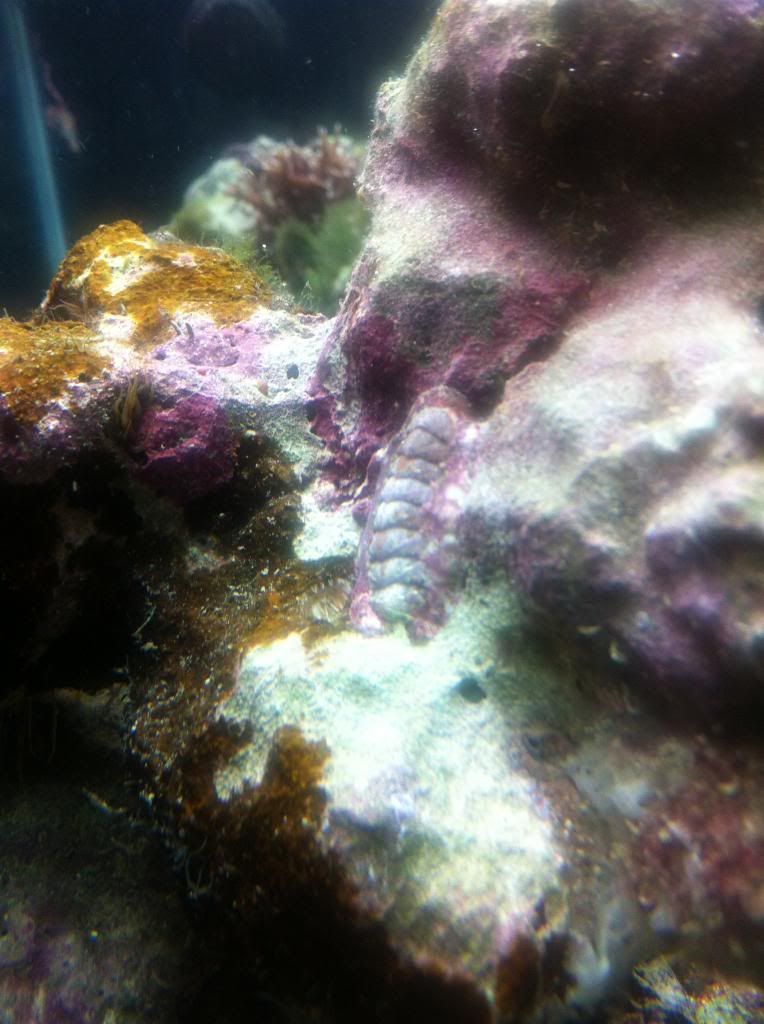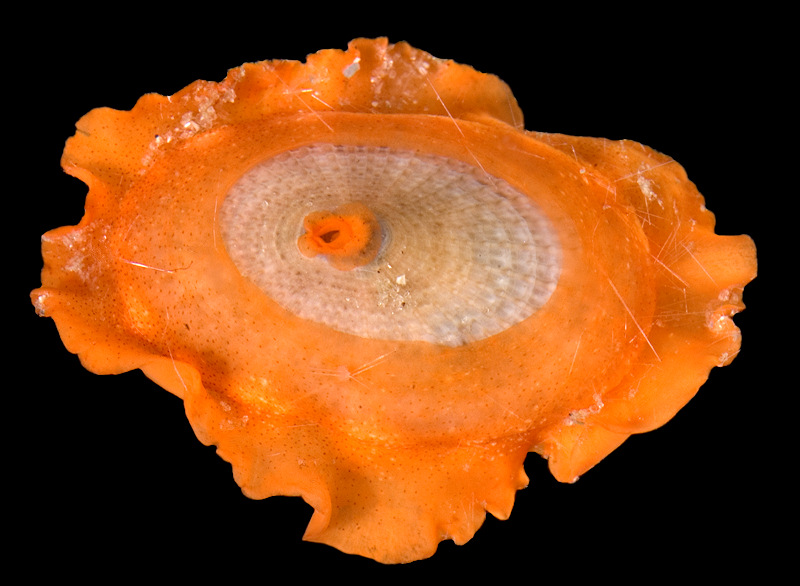You are using an out of date browser. It may not display this or other websites correctly.
You should upgrade or use an alternative browser.
You should upgrade or use an alternative browser.
WTH? Discovered this morning
- Thread starter Creekview
- Start date
Oxylebius
Well-Known Member
Slugs that look like ricordea are onchidiids, which are a group of marine pulmonate slugs.
From the sea slug forum: The onchidioideans are shell-less slug-like marine molluscs. They range in size from 10-70mm long. They are usually oval in shape with a hard leathery mantle which ranges from smooth in some species to tuberculate in others. Some species have gill-like papillae scattered over the back and in other species there are eye-like sensory structures on the back. These relatives of the land snails have a section of the mantle cavity modified as a lung to breath air. It opens through a pore alongside the posteriorly opening anus, below the mantle.
Onchidiids live intertidally, often in sheltered estuaries on rocks, mud, and in mangrove swamps. They are also found on limestone cliffs with wide raised intertidal limestone platforms. Little has been published on their natural history but it is thought they feed on the organic film of diatoms, other algae, and bacteria which coat rocks and mud on sheltered intertidal shores. Genera include Onchidium, Onchidella, Onchidina and Platevindex.
From the sea slug forum: The onchidioideans are shell-less slug-like marine molluscs. They range in size from 10-70mm long. They are usually oval in shape with a hard leathery mantle which ranges from smooth in some species to tuberculate in others. Some species have gill-like papillae scattered over the back and in other species there are eye-like sensory structures on the back. These relatives of the land snails have a section of the mantle cavity modified as a lung to breath air. It opens through a pore alongside the posteriorly opening anus, below the mantle.
Onchidiids live intertidally, often in sheltered estuaries on rocks, mud, and in mangrove swamps. They are also found on limestone cliffs with wide raised intertidal limestone platforms. Little has been published on their natural history but it is thought they feed on the organic film of diatoms, other algae, and bacteria which coat rocks and mud on sheltered intertidal shores. Genera include Onchidium, Onchidella, Onchidina and Platevindex.
Love the color! Spotted another one, same color but smaller. I'm gonna assume he's safe to keep.
Before you assume any Nudibranch is safe to keep in your tank....I think you better research & make sure.
MOST are NOT REEF-SAFE from what I read when I was trying to find out.
Oxylebius
Well-Known Member
Little has been published on their natural history but it is thought they feed on the organic film of diatoms, other algae, and bacteria which coat rocks and mud on sheltered intertidal shores. Genera include Onchidium, Onchidella, Onchidina and Platevindex.
What I posted above indicates that they are safe. If you've also had it for a long while and haven't had any issues, this also indicates that they are safe. Since many unsafe slugs and nudibranchs are specialized feeders, you would already know if they were going after your corals.
Any chance you can post a pic on what it looks like from the top. Would like to see it.
Mike Johnson
Well-Known Member
Truly, I hate to be contrary. By examination of the mouth parts of the subject: It is definitely not a nudibranch. It has a mouth like a Scutus or a Limpet. Because of its orange color I ruled out Scutus. Thus, have come to the conclusion that it is a Lucapina suffusa, which is a common hitchhiker on Florida live rock. Or it could be a Lucapina sowerbii. Common name would be Orange Fleshy Limpet.
http://ts1.mm.bing.net/th?&id=HN.607986400955140563&w=300&h=300&c=0&pid=1.9&rs=0&p=0
http://ts1.mm.bing.net/th?&id=HN.607986400955140563&w=300&h=300&c=0&pid=1.9&rs=0&p=0
Not all limpets are reef safe, are they?
Mike Johnson
Well-Known Member
Yes, Limpets are considered reef safe as they are specifically algae eaters. They are, however, prolific breeders; so expect to see lots of little ones. If you don't have enough algae I'd consider giving some of the babies away.
I thought there were some varieties that not.
I found this on WebWebMedia.com. Anthony is specifically speaking about the Orange Frilly Limpet - Lucapina aegis.
Orange Frilly Limpet - Lucapina aegis Can you ID this? <yep> It's in a reef tank. Is it bad or good , Friend or foe.. <foe... as most limpets ultimately are. They are somewhat indiscriminate feeders on benthic life forms. The brighter colors are usually a giveaway (noxious and freely predating on desirable reef life - perhaps corals or sponges). Its best to remove this species and a tank without reef invertebrates. Best regards, Anthony>
I found this on WebWebMedia.com. Anthony is specifically speaking about the Orange Frilly Limpet - Lucapina aegis.
Orange Frilly Limpet - Lucapina aegis Can you ID this? <yep> It's in a reef tank. Is it bad or good , Friend or foe.. <foe... as most limpets ultimately are. They are somewhat indiscriminate feeders on benthic life forms. The brighter colors are usually a giveaway (noxious and freely predating on desirable reef life - perhaps corals or sponges). Its best to remove this species and a tank without reef invertebrates. Best regards, Anthony>
Mike Johnson
Well-Known Member
Okay, you present a very good argument. I will have to regress. I am much more tolerant of hitchhikers than your average saltwater aquarist. I am a fan of Anthony Calfo and have all his books. So, in order to address this issue I looked up what he had to say about Limpets in his book "Reef Invertebrates".
"Numerous species occur in the marine aquarium by way of collection and incidental acquisition with hard substrates. They are voracious algae grazers that are not always useful for the mixed invertebrate aquarium. Although most are herbivorous, some are predatory like the coral-grazing Caribbean Orange Limpet, (Lucapina) and the fleshy mantled Black Limpet (Scutus). Even among the algae grazing species, they can be devastating to desirable algae forms like corallines, as well as nuisance forms. Some also reproduce prolifically in the aquarium for better or for worse. While we would not dissuade you from keeping an active algae-grazing limpet, we do suggest that you restrict them to mature systems with reliable growth of algae to sustain them. There is some concern with limpets denuding young or weak batches of live rock of vital coralline, which could invite undesirable algae species to settle instead. Legend has it that their very dense radula and strong rasping action can abrade the interior surface of acrylic aquariums too. As some consolation, many limpet species will stay in one spot (like one rock) for most of their lives if sufficient algae can be grown there."
Although I don't have a Lucapina, I do have lots of limpets which never have caused damage to anything desirable. I would compare the Orange Limpet to my Chitons though. Computer crashed before I finished post. See how this Chiton keeps its favorite rock clean.

"Numerous species occur in the marine aquarium by way of collection and incidental acquisition with hard substrates. They are voracious algae grazers that are not always useful for the mixed invertebrate aquarium. Although most are herbivorous, some are predatory like the coral-grazing Caribbean Orange Limpet, (Lucapina) and the fleshy mantled Black Limpet (Scutus). Even among the algae grazing species, they can be devastating to desirable algae forms like corallines, as well as nuisance forms. Some also reproduce prolifically in the aquarium for better or for worse. While we would not dissuade you from keeping an active algae-grazing limpet, we do suggest that you restrict them to mature systems with reliable growth of algae to sustain them. There is some concern with limpets denuding young or weak batches of live rock of vital coralline, which could invite undesirable algae species to settle instead. Legend has it that their very dense radula and strong rasping action can abrade the interior surface of acrylic aquariums too. As some consolation, many limpet species will stay in one spot (like one rock) for most of their lives if sufficient algae can be grown there."
Although I don't have a Lucapina, I do have lots of limpets which never have caused damage to anything desirable. I would compare the Orange Limpet to my Chitons though. Computer crashed before I finished post. See how this Chiton keeps its favorite rock clean.

I just don't want ones that will eat my corals. I found a limpet larger than a quarter in my tank several weeks ago. I had removed a smaller one a couple of weeks before. The large one that I removed was sitting in the middle of red montipora cap. It is now in my flower bed.....
Good read all !
here another pic I found googling... Lucapina suffusa

Still not 100% sure what he is... but learning
here another pic I found googling... Lucapina suffusa

Still not 100% sure what he is... but learning
In the OP pic, am I seeing optical or sensory tentacles?
Fun leaning about HH & getting ids on them while learning, especially for one like me with no degrees in anything related...
while learning, especially for one like me with no degrees in anything related...
Fun leaning about HH & getting ids on them
 while learning, especially for one like me with no degrees in anything related...
while learning, especially for one like me with no degrees in anything related...I have to say, the post before this made me chuckle and I needed it after first day back at work after a two week vacation with no one to fill in for me while I was out.....
Thanks. lsmile:
lsmile: lsmile:
lsmile:
Thanks.

